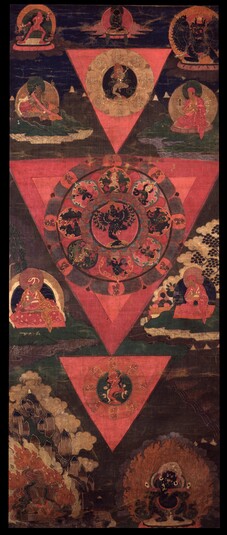
Item: Mandala of Hevajra (Buddhist Deity)
| Origin Location | Tibet |
|---|---|
| Date Range | 1600 - 1699 |
| Lineages | Sakya, Ngor (Sakya) and Buddhist |
| Size | 87.63x50.80cm (34.50x20in) |
| Material | Ground Mineral Pigment, Fine Gold Line on Cotton |
| Collection | Rubin Museum of Art |
| Catalogue # | acc.# P1995.21.10 |
Classification: Deity
Shri Hevajra as depicted during a 'Torma' Offering ritual (Tibetan: pal kye pa dor je).
Sanskrit: Hevajra Tibetan: Gye pa dor je
Tibetan: Gye pa dor je
In the central red triangle on a large lotus seat is Shri Hevajra, dark blue in colour, with eight faces and sixteen hands holding skullcups, and four legs in a dancing posture. The first pair of arms embrace the consort Vajra Nairatmya (Selfless One), dark blue, with one face and two hands holding a curved knife and skullcup, standing on the left leg with the right embracing Hevajra. Adorned with bone ornaments they stand atop a lotus within the flames of pristine awareness.
Surrounding the central figures are eight goddesses of various colours, each with one face and two hands, standing in a dancing posture on the left leg above a corpse and lotus petal. Beginning from the top and proceeding in a clockwise direction is yellow Vetali, multi-coloured Dombini, green Ghasmari, blue Pukkasi, black Gauri, white Shavari, red Cauri, and purple Candali. Adorned with bone ornaments and a necklaces of fifty skulls, each holds their own distinct hand objects. On the outside circle of lotus petals are the eight great worldly guardians: Shakra, Yama, Varuna, Yaksha, Agni, Raksha, Vayu and Ishana. Blue in colour with one face and two hands they each embrace a consort.
In the upper red triangle is Kayavajra Hevajra, white, with one face and two hands embracing the consort, in a dancing posture; surrounded by the eight great gods; Maheshvara, Indra, Brahma, Vishnu, Takkiraja, Ganapati, Bhrngiriti and Kumarakartika. White in colour with one face and two hands they embrace a consort.
In the lower red triangle is Vakvajra Hevajra, red, with one face and two hands embracing the consort, in a dancing posture; surrounded by the eight great nagas; Karkota, Shankhapala, Ananta, Vasuki, Takshaka, Kulika, Padma and Mahapadma. Red in colour with one face and two hands they embrace a consort.
At the top center is the primordial buddha Vajradhara, blue, with one face and two hands holding a vajra and bell, seated in vajra posture. To the left stands Vajrayogini, red, with one face and two hands holding upraised a blood filled skullcup and in the right hand a curved knife pointed downward. On the right is the blue-black, buffalo headed tutelary deity, Vajra Bhairava, with nine faces, thirty-two hands and sixteen legs.
Below on the left is mahasiddha Virupa, dark brown in colour, holding up the left hand in a wrathful gesture; wearing a red meditation belt. On the right is a Sakya Pandita wearing monastic robes and a red pandita hat, performing the Dharma Teaching mudra (gesture) and holding two lotus stems with the blossoms supporting a sword and book. Below those, on the left is Ngorchen Sanggye Puntsog (1649-1705), 25th abbot of Ngor, wearing monastic robes and a red pandita hat with the lappets folded over the crown of the head in a popular Sakya fashion. On the right is another lama in similar appearance wearing a pandita hat.
At the bottom right and left are the two main Sakya Mahakalas (Tib.: gon po che chung). On the left is the Brahmarupa Mahakala appearing as an Indian sage holding a skullcup in the right hand and blowing a shin-bone trumpet held in the left. To the right is Panjarnata Mahakala, black, with one face and two hands holding a curved knife and skullcup and an emanation stick across the forearms, surrounded by the flames of pristine awareness wisdom.
Shri Hevajra is a tutelary deity of the anuttarayoga non-dual classification. From the many Hevajra Tantras and forms of the deity this representation of Hevajra arises from the root Hevajra Tantra of 'Two Sections.' The subject of the painting is unique. The three mandalas and red triangle seats are central to the process of offering ritual 'torma' (stylized food) to Shri Hevajra. The textual tradition was popularized by the Indian mahasiddha Durjayacandra.
Lineage: Vajradhara, Nairatmya, Virupa, Acarya Dombi Heruka, Alala Vajra, Nag Tropa, Garbharipa, Jaya Shrjnana, Acarya Durjayachandra, Bikshu Viravajra, Drogmi Lotsawa, Ngaripa Salwa'i Nyingpo, Khon Gyichuwa Drala Bar, Sachen Kunga Nyingpo (1092-1158), etc.
Jeff Watt 6-98
Numbered Image - Yellow:
1. Hevajra, Kayavajra (body)
2. Hevajra, Vagvajra (speech)
3. Hevajra, Cittavajra (mind)
Numbered - White:
1. Vajradhara
2. Vajrayogini
3. Vajrabhairava
4. Virupa
5. Sakya Pandita
6. Ngorchen Sanggye Puntsog (1649-1705)
7. Unidentified
8. Brahmanarupa mahakala
9. Panjarnata Mahakala
Exhibition: Mandala, The Perfect Circle (RMA)
Publications
Publication: Mandala: The Architecture of Enlightenment
Thematic Sets
Collection of RMA: Iconographically Rare Works
Collection of Rubin Museum of Art: Painting Gallery 7
Tradition: Sakya Deity Paintings
Buddhist Deity: Hevajra Main Page
Subject: Why Paintings Are Made
Glossary: Yoga Terminology
Collection of Rubin Museum of Art: Mandala
Collection of RMA: Ngor Style Paintings
Subject: Greyscale - Figurative & General Composition
Buddhist Deity: Hevajra (Three Unusual Images)
Collection of Rubin Museum (Interesting Mandalas)
Mandala: Shape, Form & Composition
Painting Tradition: Menri Page (17th Century)


